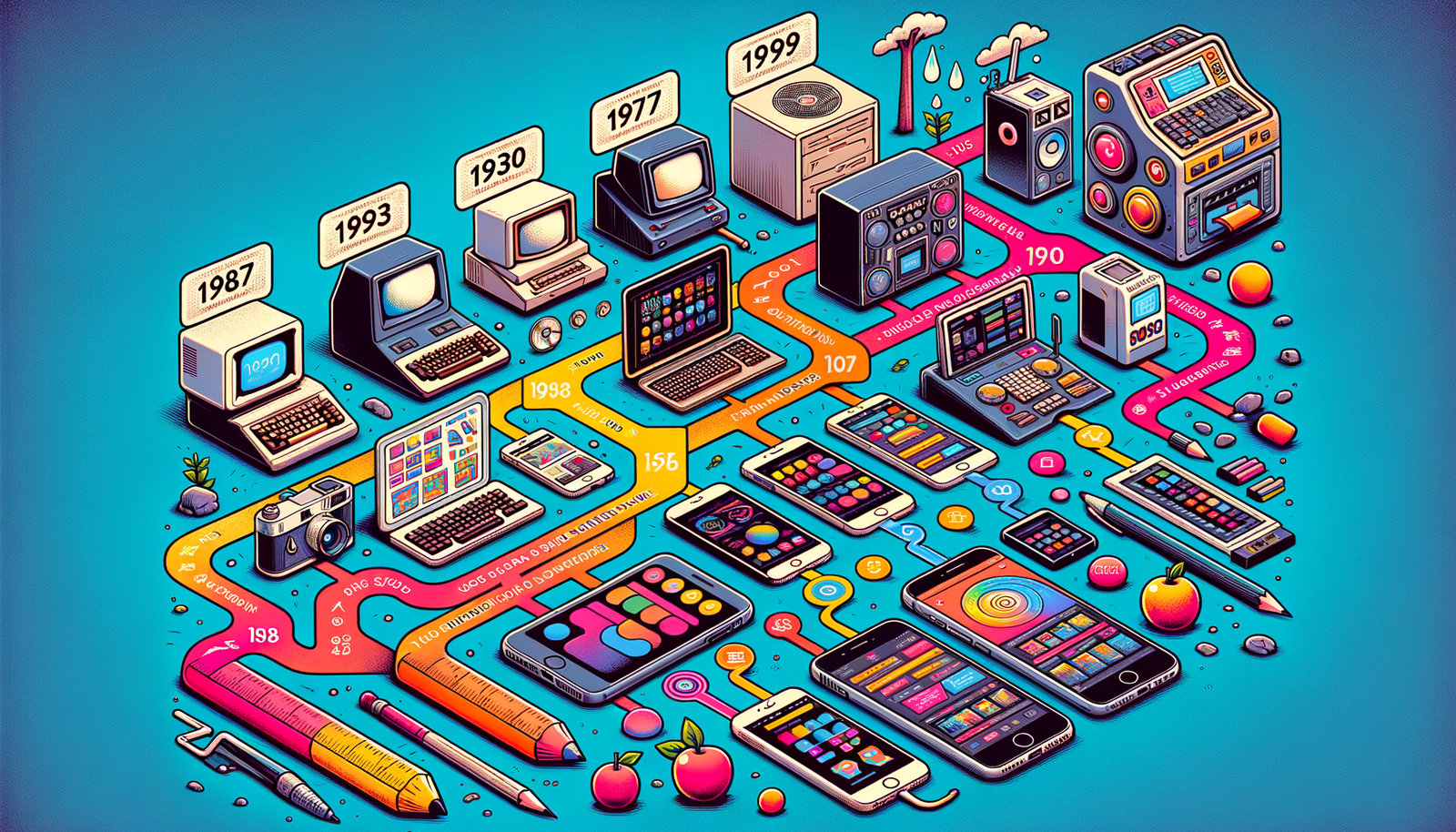Your Cart is Empty
Customer Testimonials
-
"Great customer service. The folks at Novedge were super helpful in navigating a somewhat complicated order including software upgrades and serial numbers in various stages of inactivity. They were friendly and helpful throughout the process.."
Ruben Ruckmark
"Quick & very helpful. We have been using Novedge for years and are very happy with their quick service when we need to make a purchase and excellent support resolving any issues."
Will Woodson
"Scott is the best. He reminds me about subscriptions dates, guides me in the correct direction for updates. He always responds promptly to me. He is literally the reason I continue to work with Novedge and will do so in the future."
Edward Mchugh
"Calvin Lok is “the man”. After my purchase of Sketchup 2021, he called me and provided step-by-step instructions to ease me through difficulties I was having with the setup of my new software."
Mike Borzage
Design Software History: The Evolution and Impact of Mobile Apps in Design Software History
August 09, 2024 7 min read


Introduction
In the rapidly evolving landscape of design software, the introduction of mobile applications has marked a significant turning point. This article explores the rich history, transformative impact, key players, and future trends of mobile apps in design, offering an in-depth analysis of how these tools have revolutionized the industry.
The Emergence of Mobile Apps in Design
The Early Days of Mobile Computing
The journey of mobile computing in design began with the advent of the first mobile devices capable of running design software. The late 2000s saw the introduction of smartphones and tablets, devices that would lay the groundwork for a new era in design technology. The launch of the iPhone in 2007 and the subsequent release of the iPad in 2010 by Apple Inc. were pivotal moments. These devices brought with them advanced touchscreens and user-friendly interfaces, setting the stage for mobile apps in design.
As the hardware capabilities of smartphones and tablets advanced, so too did their potential for running increasingly sophisticated software. The rapid development of mobile processors, improved touch sensitivity, and the introduction of stylus support made these devices more suitable for design applications. This period marked the beginning of a shift in how designers approached their work, moving from static desktop environments to dynamic, on-the-go solutions.
Pioneering Companies and Innovators
A few key players were instrumental in the early days of mobile design apps. Autodesk, a stalwart in the design software industry, was one of the first to venture into this new territory. Their app, Autodesk SketchBook, launched in 2009 for the iPhone, was a significant milestone. It provided a robust set of tools for sketching and drawing, demonstrating the potential of mobile devices for serious design work.
Another notable innovator was Adobe Systems. Recognizing the growing importance of mobile platforms, Adobe released several mobile versions of its popular software. Adobe Ideas, which later evolved into Adobe Illustrator Draw, was an early entry that showcased the possibilities of vector graphics on mobile devices.
These companies, among others, paved the way for a new wave of mobile design applications, setting the foundation for future advancements and inspiring other developers to explore the untapped potential of mobile design.
Technological Advancements
The evolution of mobile design apps has been closely tied to advancements in hardware and software. Improved touchscreens, such as those featuring multi-touch capabilities, allowed for more precise and intuitive interactions. The introduction of high-resolution displays, like Apple's Retina Display, provided designers with detailed and vibrant canvases.
Stylus support, exemplified by devices like the Samsung Galaxy Note and the Apple Pencil, brought a new level of precision and control to mobile design. These tools enabled designers to replicate the feel and accuracy of traditional drawing instruments, further bridging the gap between mobile and desktop design experiences.
On the software side, innovations such as cloud storage and real-time collaboration tools have been game-changers. Services like Dropbox, Google Drive, and Adobe Creative Cloud allowed designers to store and access their work from anywhere, facilitating seamless collaboration and flexibility. Real-time collaboration features, present in apps like Figma and Adobe XD, enabled teams to work together on projects simultaneously, regardless of their physical location.
Transformative Impact on Design Processes
Accessibility and Democratization
One of the most significant impacts of mobile design apps has been their role in making design tools more accessible to a broader audience. Traditional design software often required expensive hardware and software licenses, creating barriers for many aspiring designers. Mobile apps, however, have lowered these barriers, offering affordable or even free alternatives that can be used on widely available devices.
Apps like TinkerCAD have democratized design by providing user-friendly interfaces and simplified workflows. These tools enable non-professionals, including hobbyists and students, to engage in design activities without the need for extensive training or expensive equipment. This democratization has led to a surge in creativity and innovation, as more people can participate in the design process.
Portability and Flexibility
The portability and flexibility offered by mobile design apps have been revolutionary. Designers are no longer confined to their desks and can now work from virtually anywhere. This is particularly beneficial for professionals who need to be on-site or travel frequently. For instance, architects can now review and edit plans directly on construction sites, making real-time adjustments and improving communication with contractors.
Similarly, graphic designers and illustrators can capture inspiration on-the-go, creating sketches and concepts as they move through their daily lives. This increased flexibility has enabled more spontaneous and dynamic workflows, enhancing creativity and productivity.
Integration with Desktop Software
Rather than replacing traditional desktop design software, mobile apps have often complemented these tools, creating a more integrated and versatile workflow. Many mobile design apps are designed to work seamlessly with their desktop counterparts, allowing for easy transfer of work between devices.
Adobe Creative Cloud is a prime example of this integration. Designers can start a project on their desktop using Adobe Photoshop or Illustrator and continue refining it on their tablet or smartphone with apps like Adobe Photoshop Express or Adobe Illustrator Draw. This interoperability ensures that designers can maintain their productivity regardless of the device they are using.
Key Players and Notable Applications
Autodesk
Autodesk has been a prominent player in the design software industry, and its mobile offerings have had a significant impact across various sectors. AutoCAD mobile, for instance, brings the power of its renowned desktop software to mobile devices, allowing architects, engineers, and designers to view, create, edit, and share CAD drawings on-the-go. This app has been particularly influential in fields like architecture and manufacturing, where accurate and accessible design data is crucial.
Fusion 360, another Autodesk mobile application, offers a comprehensive set of tools for 3D CAD, CAM, and CAE. Its mobile version enables designers to collaborate on projects, view design iterations, and make necessary adjustments from their mobile devices, enhancing the overall design workflow.
Adobe Systems
Adobe Systems has been at the forefront of integrating mobile design tools into its extensive ecosystem. Adobe Illustrator Draw and Photoshop Express are two notable mobile applications that have gained widespread popularity among graphic designers. Illustrator Draw allows users to create vector illustrations with precision, while Photoshop Express offers powerful editing tools for photos, all from mobile devices.
These mobile tools are designed to work seamlessly with Adobe's desktop applications, providing a cohesive and flexible design experience. Adobe's mobile strategy focuses on enabling creativity anytime and anywhere, ensuring that designers have the tools they need at their fingertips.
Emerging Startups and Innovators
In addition to established companies, several emerging startups and innovators have made significant contributions to the mobile design app landscape. Procreate, developed by Savage Interactive, has become a favorite among illustrators and artists for its powerful and intuitive drawing features. The app offers a wide range of brushes, layers, and other tools that rival those of desktop software, making it a go-to choice for digital artists.
Other notable innovators include concepts like Affinity Designer, which offers professional-grade vector and raster design tools, and Shapr3D, a mobile CAD application that brings advanced 3D modeling capabilities to tablets. These emerging players have introduced fresh ideas and innovative functionalities, challenging established companies and pushing the boundaries of what mobile design apps can achieve.
Future Trends and Challenges
Technological Advancements
The future of mobile design apps is closely tied to ongoing technological advancements. Augmented reality (AR) features are expected to become more prevalent, allowing designers to visualize and interact with their creations in real-world environments. This technology can provide new dimensions to design processes, particularly in fields like interior design and architecture.
AI integration is another promising trend. AI-powered tools can assist designers by automating repetitive tasks, generating design suggestions, and enhancing creativity through machine learning algorithms. These advancements have the potential to significantly boost productivity and innovation in design.
Enhanced real-time collaboration and more powerful processing capabilities are also anticipated. As mobile devices continue to evolve, they will be able to handle more complex design tasks, further narrowing the gap between mobile and desktop design experiences.
User Experience and Interface Design
The growing importance of intuitive user interfaces (UX/UI) in mobile apps cannot be overstated. As the competition in the mobile design app market intensifies, developers are increasingly focusing on delivering seamless and user-friendly experiences. Mobile apps like Procreate and Adobe Fresco have set new standards in UX/UI design, offering interfaces that are both powerful and easy to navigate.
Creating intuitive and responsive interfaces is crucial for ensuring that users can fully leverage the capabilities of mobile design apps. This emphasis on user experience will continue to shape the development of future applications, driving innovation and improving usability.
Challenges and Limitations
Despite their many advantages, mobile design apps still face several challenges and limitations. One of the primary issues is the difference in screen size compared to desktop monitors. The smaller screens of mobile devices can make it difficult to work on intricate designs, limiting the level of detail that can be achieved.
Input methods are another challenge. While stylus support has improved, it still may not match the precision and familiarity of a mouse and keyboard. Processing power is also a concern, as mobile devices typically have less computational capability than high-end desktops, which can impact performance when handling complex design tasks.
- Security concerns and data privacy are also significant issues. Mobile devices are often more vulnerable to security breaches, and ensuring that sensitive design data is protected is a critical consideration for both developers and users.
Predicted Industry Shifts
Looking ahead, the role of mobile apps in design is expected to evolve significantly. The integration of emerging technologies such as 5G and edge computing could further enhance the capabilities of mobile design apps. Faster data transfer speeds and lower latency will enable more seamless real-time collaboration and access to cloud-based resources.
Additionally, the continued development of AR and AI technologies will open new possibilities for mobile design, allowing for more immersive and intelligent design experiences. These advancements will likely lead to the creation of even more sophisticated and versatile mobile design tools, further blurring the lines between mobile and desktop design environments.
In conclusion, the history and evolution of mobile design apps have been marked by significant milestones and innovations. From the early days of mobile computing to the present, these tools have transformed design processes, making them more accessible, flexible, and integrated. As technology continues to advance, mobile design apps will undoubtedly play an increasingly important role in shaping the future of design.
Also in Design News

Cinema 4D Tip: Matrix-Driven Instancing for High-Performance Scattering
December 20, 2025 2 min read
Read More
V-Ray Tip: V-Ray Anisotropy Techniques for Brushed Metals and Hair
December 20, 2025 2 min read
Read More
Revit Tip: Revit Nested Tagging: Shared Nested Families and Roll-Up Parameters
December 20, 2025 2 min read
Read MoreSubscribe
Sign up to get the latest on sales, new releases and more …


